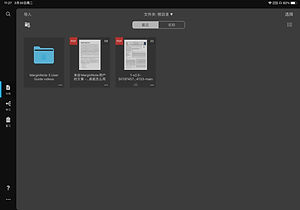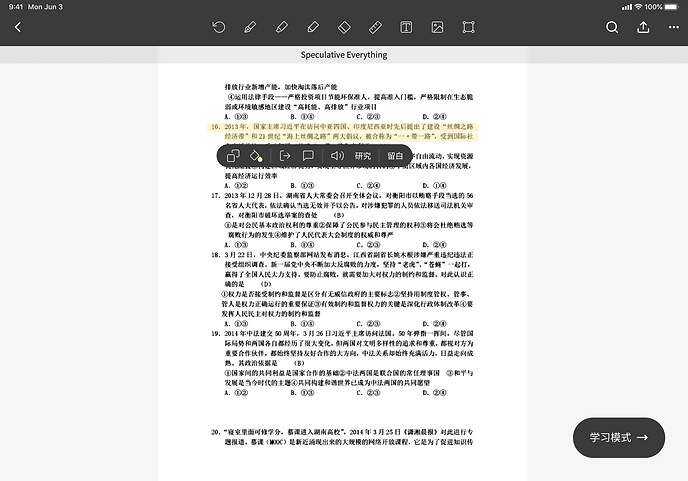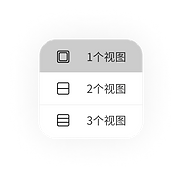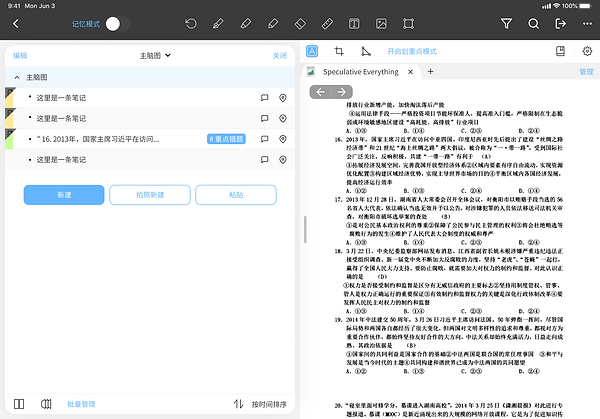
MarginNote App
-User Scenario Optimization
UX & UI Designer | March 2021 - June 2021
Project Objectives
Pain Point Exploitation
Version Definition
User Experience Enhancement
Through business interviews and user interviews, we find the product pain points and target the starting problems and needs.
Define clear product startup version content and related mechanisms based on business objectives.
Based on pain point excavation, strengthen the product experience of users' main scenario process.
Product Introduction
MarginNote is a powerful reading, note-taking tool that combines a PDF / ePub reader with a variety of powerful note-taking tools that allow us to regroup our knowledge while reading e-books to deepen our memory.
Applicable people / target group
People who need to read a lot of papers
Reviewing and preparing for the exam
People who are learning a new language/have a need for self-testing memory
Users who need to read and organize a large number of documents, and need to read and understand passages in a close manner to mark and organize them for quick recap and review afterwards.
Organize multiple literature notes for consistency and quick review of relevant knowledge points at a glance. Organize and memorize mistakes on tested papers.
Those that require a lot of memorization and self-testing needs, including word memorization and retesting of wrong questions.
Main application disciplines: biology, medicine and liberal arts that require a lot of memorization, less suitable for physics and mathematics that require more understanding of computation.
Applicable scenarios
Learning new knowledge absorption scenarios
Quickly organize the content of existing materials and sort out the outline to extract the parts you need from a large amount of information and manage the knowledge in a structured way.
Reviewing old knowledge and recalling scenarios
Quickly browse and recall the contents of existing notebooks, make cards for important contents or contents that are not easy to remember and use the memory curve to cycle test the contents that need to be remembered.
Not Applicable Scenarios
Content creation on the basis of no information
Not suitable for creating "nothing" documents such as classroom notes or daily essays
High frequency scenarios
Reading and Learning
Structured organization of notes
Making Memory Cards
Read the target document imported as a PDF, excerpt and annotate the key points.
The excerpted highlights are structured and highlighted to complete an in-depth understanding of the entire document and to review it again.
Use the memory curve to focus on memorizing and consolidating structured content to complete the learning loop.
Related Features
Related Features
Related Features
[Excerpt] use the tool to make excerpts of important content in conjunction with the requirements.
[Annotation] leaving a record of the content to be annotated using the selection tool.
[Research] translation and analysis of questionable content fields, etc..
[Note Cards] to edit and optimize the content of notes, adding relevant understanding, such as: voice, photos and doodles, etc.
[Create Node] Framing and editing according to the content of document excerpts, similar information for connection.
[Categorization and Grouping] color classification and organization of content at the same level.
[Annotation] Handwritten annotation processing of key content.
[Add cards] to sort out and memorize the contents of the front and back pages of the cards.
[Play] to perform memory test on key contents.
[Highlight] to fill in the blanks and memorize the content of key passages or phrases.
Product main features sorting
Document
Importing documents that need to be read and learned is in parallel mode with the learning board and functions mainly as a source file storage station. Documents in the Document tab and documents in the Study tab can be made one-to-one, one-to-many and many-to-one.
Study
Notebooks created from document content, within which mind map output of key content can be performed, and fragmented content can be transformed into cards to serve later consolidation tests.


Revise
The cards are composed of the output of the key contents in the mind map, and the card groups are created independently. With the memory curve to better help users to consolidate the memory of key content.
Feature Model

revise
Document
Revise
Study
start structured learning
key content memory
Start a new round of learning



Competitor List Chart

read
professional
create
light
Target user interviews
Expert Users
Lost Users
-
High frequency of use, preferably with scenarios that require the use of MN every day.
-
Know a lot of uncommon features, or special usage and scenarios of common features.
-
Experienced many version updates, have a deep understanding of version updates and different feature iterations.
-
Used to use MN frequently, but finally gave up using it.
-
There are a few functions that are more commonly used and fixed to accomplish some reading or organizing tasks.
New Users
-
Liberal arts or biology major with extensive reading and memorization needs.
-
Just downloaded MN and have experience with similar notes and reading aids.

Recruiting situation
Expert Users (4)
Lost Users (2)


New Users (4)


Discussion Guide
Current Situation
-
Study Status
-
Work Status
MarginNote Related
-
Motivation to use
-
Getting Started Test
-
Current Usage
-
Task Check
Competitor Related
-
Similar Products
-
The relationship between the use of different products
-
Commonly used functions
Functional validation
-
Beginner's Guide
-
Advanced Features Guide
-
Future feature vision and outlook
Expert User
%20(1).png)
Main application scenarios
High-order functions for high frequency use
[Read Books]
[Integration of Documents/Frameworks]
[Essay Writing Aids]
[Notes]
[Speech Practice]
[Infinite Drafts]
[Memory cards]
[Wrong Question Organization/Review]
[Labeling]
[Handwriting]
[Summary]
[Link]
[Copy]
Main Features
Clearer purpose of software use
More customizable use of function combinations
A more efficient way to use cross-platform
These users have a clearer understanding of their needs and are able to accurately detect the requirements of the software between each need to develop their own usage.
They have a systematic and comprehensive understanding of functional knowledge, so the needs of different scenarios can be completed efficiently or satisfied to the maximum extent, and find the right solution to combine the use of a variety of functions.
Good at mobilizing more external software to fill in the gaps and meet the needs of their different equipment scenarios
Lost Users
%20(1).png)
Main application scenarios
High-order functions for high frequency use
[Read Books]
[Integration of Documents/Frameworks]
[Memory cards]
[Excerpt]
[Summary]
[Link]
[Tags]
Main Features
Have a clear purpose for the use of MN
A more effcient option
They have a clear understanding of their own needs and the positioning of MN, and when things don't work out, they can identify and summarize the shortcomings in time to find alternative solutions.
They find software that more directly meets their needs, rather than spending time exploring other features of MN that meet the needs of the scenario
New Users
%20(1).png)
Main application scenarios
High-order functions for high frequency use
[Read Books]
[Integration of Documents/Frameworks]
[Library]
[Note]
[Journal]
[Citation]
[Link]
[Camera]
Main Features
Imitation-based scenario use
Exploratory function discovery
For their own needs perception and product features are still in the exploration stage, can not be customized to meet the needs of the scenario, must be obtained through other channels samples for the use of the set-in mode.
The function exploration is based on the inspirational documents, and it is not possible to precisely target the functions according to the requirements, which makes the use and operation less efficient in the context of "powerful software".
Main scene combing

Scenario 1: A large number of problem solving scenarios
Ideal for users who need to keep up with their exams at all times and complete a large number of questions and complete the classification of questions, error management, etc.
Scene Purpose
Use real-life questions to consolidate the ability to apply knowledge and understand the true real-life appearance of knowledge points
Main Features
[Excerpts] For document excerpts
[Comment] Explain the topic
[White space] for preliminary calculations
[Labeling] To classify and manage errors

Answering questions
Judgment
Classification
Creating a Question Bank
Importing Books
Make excerpts
Add a card
Scene 2: In-place memory scene
For users who need to make a pre-test assault, concentrating on memorizing the basic knowledge briefly in the textbook and teaching aids
Scene Purpose
After forming a general understanding of the textbook, it is convenient for users to focus on the necessary knowledge points for problem solving and quick memory.
Main Features
[Tree Mode] Step-by-step recall
[Recall Mode] Recall and consolidate existing contents
[Highlighting] Strengthen the memory of key contents
[Tagging] To classify and manage mistakes

Importing Books
Make excerpts
Organize them
Turn on the
Recall Mode
Difficulty in
selection
Intelligent
recall mode
Autonomous
recall mode
Add to cards
Scene 3: Note-taking scene in class
Users in class mainly listen to the framework of the teacher's ideas, and efficiently record the main points of the board to produce guidance for the focus of learning after class
Scene Purpose
Generate a framework for classroom comprehension and post-lesson review through quick and easy documentation
Main Features
[Outline] for quick note taking

Making Mind Map
by hand writing
Importing textbook
Forming
Mind map
taking
notes
Organizing
Design Principle

Clear partitioning of functions
The operation area is partitioned by a consistent logic to help users quickly locate the functions they need while completing efficient operations.

Smooth linear operation
Use scenarios to clarify mainstream operational paths and help users seamlessly complete tasks that occur at high frequencies

Unified build logic
Changes in format within the zone and maximum unification of functions and operation methods to help users get started quickly and begin to complete their learning tasks.
Design output
Main Interface - Document
1. General function operation area
The ribbon spans the screen and provides a hint of all the actions the user can perform here. Here the user can annotate brain maps and documents, filter all the content, etc.
2. Document reading area
Bridging the gap between the document section and the learning section, this area supports purely reading-oriented features and provides an immersive reading area for users
3. Model transformation guidance

Guide to the main learning features and help new users to come to the learning section where they can explore more features

Main Interface - Study
1. General function operation area
The ribbon spans the screen and provides a hint of all the actions the user can perform here. Here the user can annotate brain maps and documents, filter all the content, etc.
2. Document reading area
In the document operation area users can select and operate specific functions for document content, as well as manage the order and number of documents in batches.
3. Mind map operation area

The mind map operation area is located at the bottom level, allowing users to centrally adjust the view according to their needs, while the content of the notes can be effectively managed in bulk

Scenario 1: A large number of problem solving scenarios
Scene 2: In-place memory scene
Main Feature-Recall Mode
Function Purpose
Helps users visualize memory processing methods in learning mode
Function Definition
[In Frame Recall Mode]
1. Automatic selection to the first card, the selected card changes according to the central view
2. Hide annotated content and highlighting
3. The document is put away and the draft paper pops up. After closing the draft sheet, it will not pop up again in this mode until the user opens it manually
[In Tree Recall Mode]
1. Collapses all sub-nodes, shows only one card when first opened, and hides annotated and highlighted content.
2. The user can choose to open the child nodes in sequence, or close the master node and open it again, opening all the children of that master node

Turn on the Frame Recall Mode
Tree Recall Mode
Scene 3: Note-taking scene in class
Function Purpose
Provides a faster way to generate frames for in-class notes, saving the steps of charting and arranging to complete quick notes
Function Definition
Only the formal differences with the brain map, in the core of the function to maintain a high degree of consistency, easy for users to learn and understand

Create a new class note
Usability Testing
Task 1: Create a notebook
Background Description
Users create notebooks in order to do test papers
Task Purpose
Understand users' awareness of changes to the Study home page
The main functions examined
Is [New Study Document] smooth?
Does [Import Document] work?
Does [Existing Document] understand?
Task 2: Perform an algorithmic reconciliation and extract
Background Description
The first time for the user to do the paper questions mainly requires a lot of calculations, after solving the questions the user needs to check the answers and manage the mistakes
Task Purpose
Examine the Study page to see if it meets the user's perception and the user's needs when doing the questions for the first time
The main functions examined
Is [Document Management] smooth?
Is [Multi-view] detectable?
Is [Blank Space] effective and easy to notice?
Task 3: Complete the content excerpt and management
Background Description
After having completed the paper, and manage a second exercise on the extracted wrong questions
Task Purpose
Examine the extent to which the interface features are suitable for users to replay and remember, and understand how well they match users' wrong answers.
The main functions examined
Is [Draft Paper] valid and smooth?
Is [Batch Management] effective?
Is [Recall Mode] effective and easy to detect?
Task 4: Perform In-place memory
Background Description
Turn on mind map notes for liberal arts classes that require structured memory for the exam in a few days, and focus on memorizing and managing difficult content
Task Purpose
Understand how well the Recall Mode works for liberal arts scenarios
The main functions examined
Is [Memory Mode] it effective and easy to understand?
Is [Focusing] effective and fluent?
Task 5: Outline use and management
Background Description
In-class notes are needed to organize and understand the content of the instructor's lecture and class content in a timely and quick manner.
Task Purpose
Examine the degree of awareness and use of the Outline page and the ability to edit efficiently
The main functions examined
Does [Outline New] flow smoothly?
Is [Outline Edit] smooth?
User List

Some other needs
Experienced users
New users
Calculation needs
Main optimization directions

More relevant presentation of Mind Map Notebooks and Documents
The original pattern of [Mind Map Notebook] and [Document], which were presented in a fragmented manner, was improved, connections were made, and user awareness was built.

Brain Map Notebook Tool Optimization
Integrate the [Extract] and [Tag] tools for more natural user operation. Also optimize the [Filter] tool for more intuitive result presentation.

Recall Mode operation optimization
The gap between [Recall Mode] and [Regular Mode] is bridged, allowing users to have a more immersive operating experience.

Improve the outline editing method
Provide a faster operation process, and also more in line with user perception in editing.
Task 1: Create a notebook
Test Summary
Users prefer the cleanest path: open external documents with and create brain maps directly
Global visualization of the document management interface
Document and notebook management needs to be categorized in multiple dimensions
Interface layout, icons need to be optimized

Before

After
Optimization direction
Visual association presentation of documents
-
Differential presentation of folders and documents
-
Visual presentation of associated brain map notebooks

Hierarchical management of document classification
-
The option of color at the bottom allows for parallel folder classification and color classification management to achieve multi-level management needs

Task 2: Perform an algorithmic reconciliation and extract
Test Summary
Screening for errors can be made into cards independent of the brain map and requires reminders
Need intuitive interaction for simple functions
White space function needs to be free, easy, fast and convenient to write
Interface layout, icons need to be optimized

Before

After
Optimization direction
A more systematic approach to screening and management

Quicker way to switch between views

Task 3: Complete the topic excerpt management review
Test Summary
Secondary filtering is more intuitive using colors, and tags are easy to search, without interfering with each other
Separate the two when linking/combining answers and questions
Need hints after revision of memory mode
The unorganized process on the draft is not very important, important parts can be extracted or kept
Need intuitive interaction and easy writing

Before

After
Optimization direction
Simplify handwriting and excerpting tools
-
Optimized interface presentation by merging tools
-
Merge features for a more natural and intuitive handwriting and excerpting experience
Friendly and fast card operation
-
Fast card operation and document retrieval to enhance user efficiency
-
Extracts and annotations are presented in sections to reduce user organization costs


Task 4: Perform in-situ memory
Test Summary
Need more freedom when memorizing mind maps
Need hints after updating Recall Mode revision

Before

After
Optimization direction
Clear distinction from conventional mode
-
The operation mode is separated from the regular mode, reducing the editing operation of cards and allowing users to immerse themselves in memory more
A more direct way to operate
-
The complete display of the cards by [click] is more in line with the needs of users in the scenario of memorizing and checking answers
Task 5: Outline use and management
Test Summary
Save time and reduce the number of steps required to add notes
Editing function requires WYSIWYG

Before

After
Optimization direction
Focused editorial approach
-
Card editing and quick add annotation buttons after expanding the card
-
Cards are automatically topped when editing, bringing more space and immersion for editing and annotation

Consistent switch entry
-
Eliminate the close button and use the same close method as open to reduce the user's operational awareness
